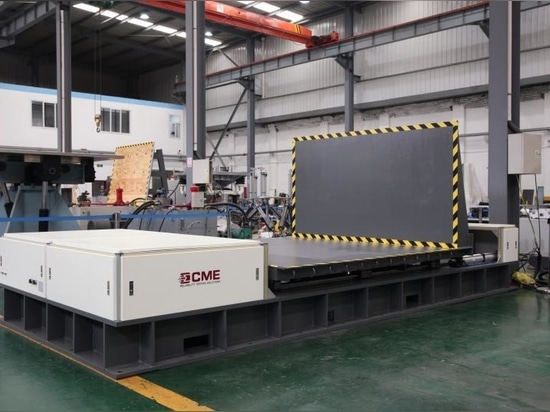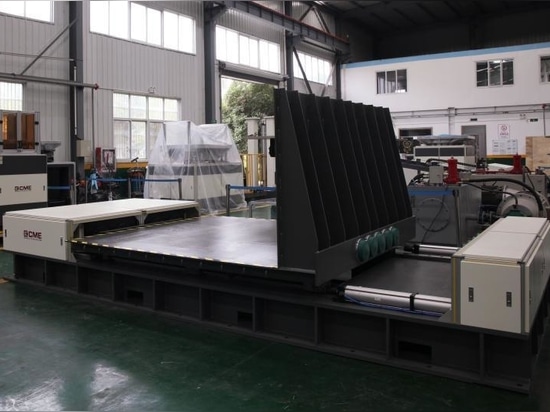What Is ISTA Shock Test?
ISTA shock test is a series of test items specified in its test standards to simulate the shock experienced by packaging during transportation and handling. Shock tests can simulate the ability of product packaging to resist shock damage in the actual environment, such as handling, stacking of shelves, sliding of motors, loading and unloading of locomotives, transportation of products, etc. These tests can understand how these shock damages affect the products in the packaging.
Before ISTA shock test
Measure the weight and dimensions of the package
You shall know the packaged-product's:
• gross weight in pounds (kg), and
• outside dimensions (LxWxH) in inches (mm or m)
Confirm the drop height and impact velocity
The test drop height varies with the weight of the packaged-product. Find the weight of the packaged-product in the following chart to determine a drop height or an equivalent impact velocity or velocity change to be used for a substituted drop:
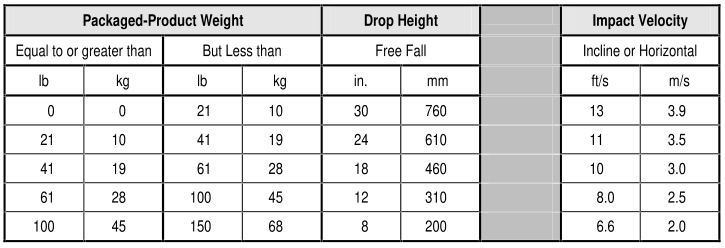
ISTA Shock Test Classification
This standard specifies the test method and apparatus, which impact surface should be either
A) a plane perpendicular to 90° (for free fall drop test)
B) a plane inclined to the vertical at 10 +/-1° (for the inclined plane test), or
C) a plane vertical to within 1° (for the horizontal or pendulum test).

Drop test (90°)
The drop test simulates the free-fall impact drop that a product or packaged product may experience during transportation and handling. The drop test is mainly to evaluate the ability of products or packaging to withstand drops during transportation and loading and unloading to improve product and packaging design. The drop height depends on the quality of the package product.
- Product weight ≤68kg: ISTA 1A, 1C, 1G, 2A, 3A, 3F
- Product weight >68kg: ISTA 1B, 1D, 1H, 2B, 3B
- Unitized Loads (Palletized): ISTA 1E, 2C, 3E
Incline impact test (10±1°)
If the incline impact testing machine is used, the minimum impact speed must reach 1.2 m/s.
The incline impact test consists of two procedures for the impact test of a loaded container or loading device (pallet load), as follows:
Procedure A, for testing the ability of a container or transport unit to withstand impact, and
Procedure B, used to test the ability of the container or transport device or the internal packaging or both to provide protection to the contents upon impact.
- Product weight ≤ 150 lbs. (68kg): ISTA 1A, 2A
- Product weight > 150 lbs. (68kg): ISTA 1B, 2B, 3B
- Unitized Loads (Palletized): ISTA 1E, 3B, 3E
Horizontal impact test (<1°)
If a horizontal impact test machine is used, the minimum impact speed must reach 1.2 m/s, and the required impact must be a half-sine wave of 10ms pulse width.
Horizontal impact tests are designed to determine the ability of a package or product to withstand a laboratory-simulated horizontal impact force.
Horizontal impacts used in horizontal impact tests are programmed impact inputs that represent hazards occurring in transportation and handling environments. Environmental hazards may include track switching effects, forklift formation effects, etc.
- Product weight ≤ 150 lbs. (68kg): ISTA 1A, 2A, 3A, 1C, 1G
- Packaged product weight > 150 lbs. (68kg): ISTA 1B, 2B, 3B, 1H
- Unitized Loads (Palletized): ISTA 1E, 3B, 3E
ISTA Shock Test Procedure (ISTA 3E)
Shock-Drop test (Take ISTA 1A for example)
Step 1 Determine the method(s) of test and the required drop height or impact velocity in Before You Begin Shock Testing.
Step 2 Do you have a packaged-product with only 6 faces as identified in Face, Edge and Corner Identification?
lf Yes, continue with the next Step.
lf No, then go to Step 6.
Step 3 Test the packaged-product according to the method(s) and level(s) determined in Step 1. Follow the sequence in the table below.
Step 4
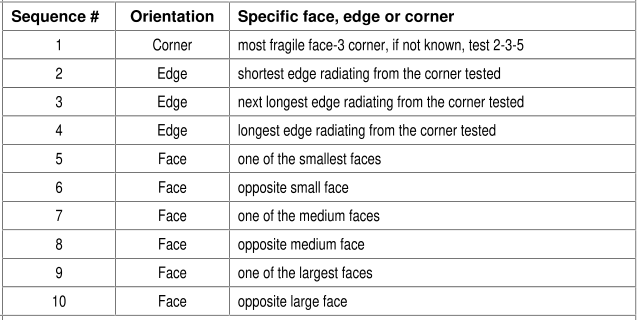
Step 5 All testing is now complete. Go to the Reporting an lSTA Test section at the end of this Procedure.
Step 6 Select a bottom face corner to replace the corner required in Step 4 Sequence 1 to begin the test.
Step 7 ldentify the edges of the packaged-product that meet the Step 4 Sequence 2 through 4 requirements.
Step 8 Select any 6 faces to replace the faces required in Step 4 Sequence 5 through 10.
Step 9 Using the corner, edges and faces from Steps 6 through 8 go to Step 3 and proceed.
Step 10 All testing is now complete. Go to the Reporting an lSTA Test section at the end of this Procedure.
Shock-Incline Impact & Horizontal Impact (Take ISTA 3E for example)
Step 1 Do the packaged-products overhang the edge of the pallet?
lf Yes, then go to Step 3.
lf No, then continue with the next Step.
Step 2 Center the unitized load on the carriage with the pallet edge flat against the backstop or sail and parallel to the leading edge of the carriage and go to Step 4.

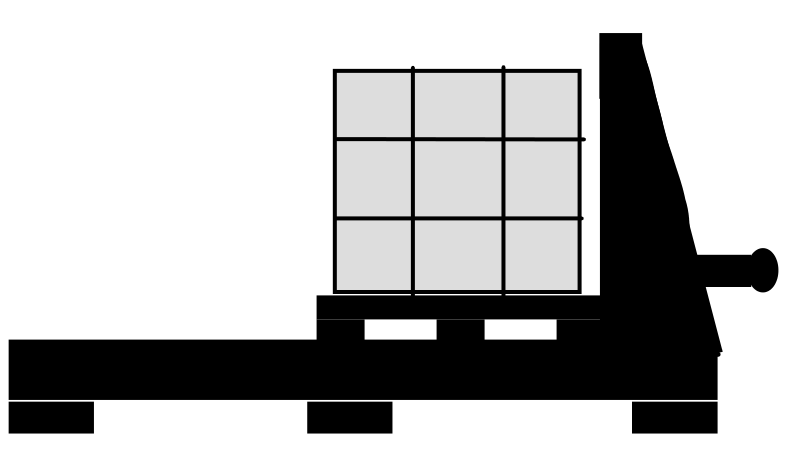
Step 3 Center the unitized load on the carriage with the pallet edge flat against the backstop or sail and parallel to the leading edge of the carriage and go to Step 4.
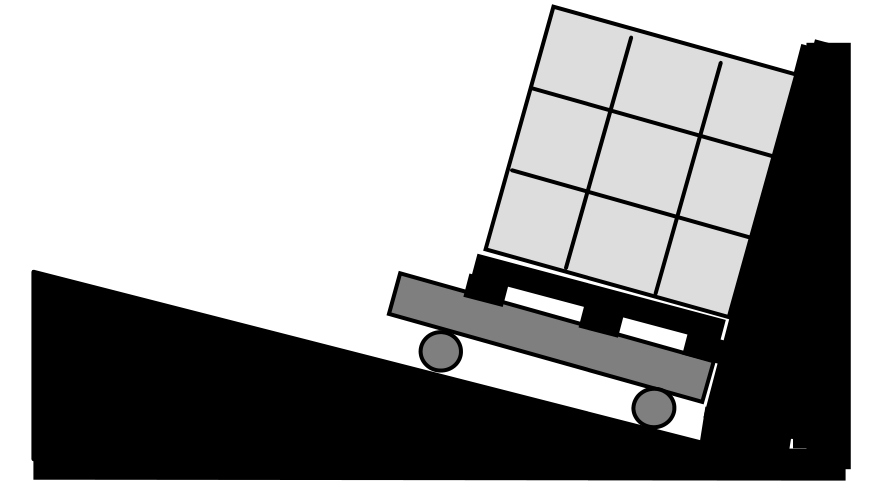
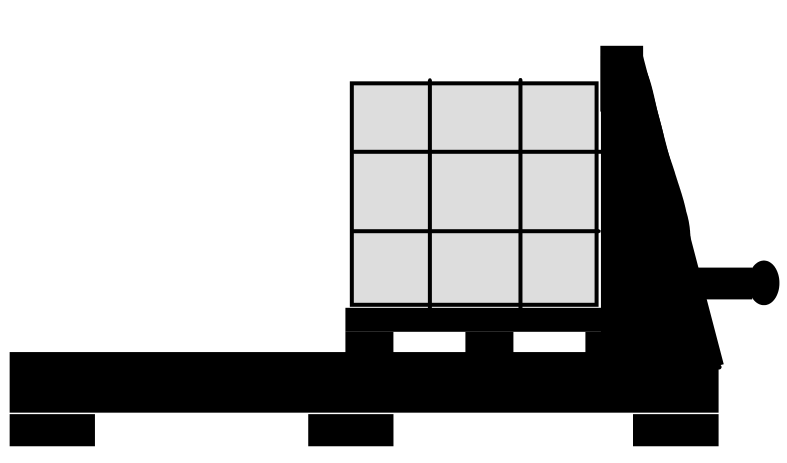
Step 4 Test the unitized load at a minimum of 48 in per second (1.2 m per second). If any velocity in a Test Sequence is below the required minimum level, that sequence event must be repeated until the test velocity meets the minimum. Follow the sequence in the table below.
Step 5 lmpact testing is now complete.
CME ISTA Shock Test Equipment
CME offers the following test equipment to perform the ISTA standard drop test, incline impact test and horizontal impact test:
- Drop Test - KRD40/KRD41/KRD42 Drop Test System
- Incline Impact - KRD100 Incline Impact Tester
- Horizontal Impact - KRD100H Horizontal Impact Tester
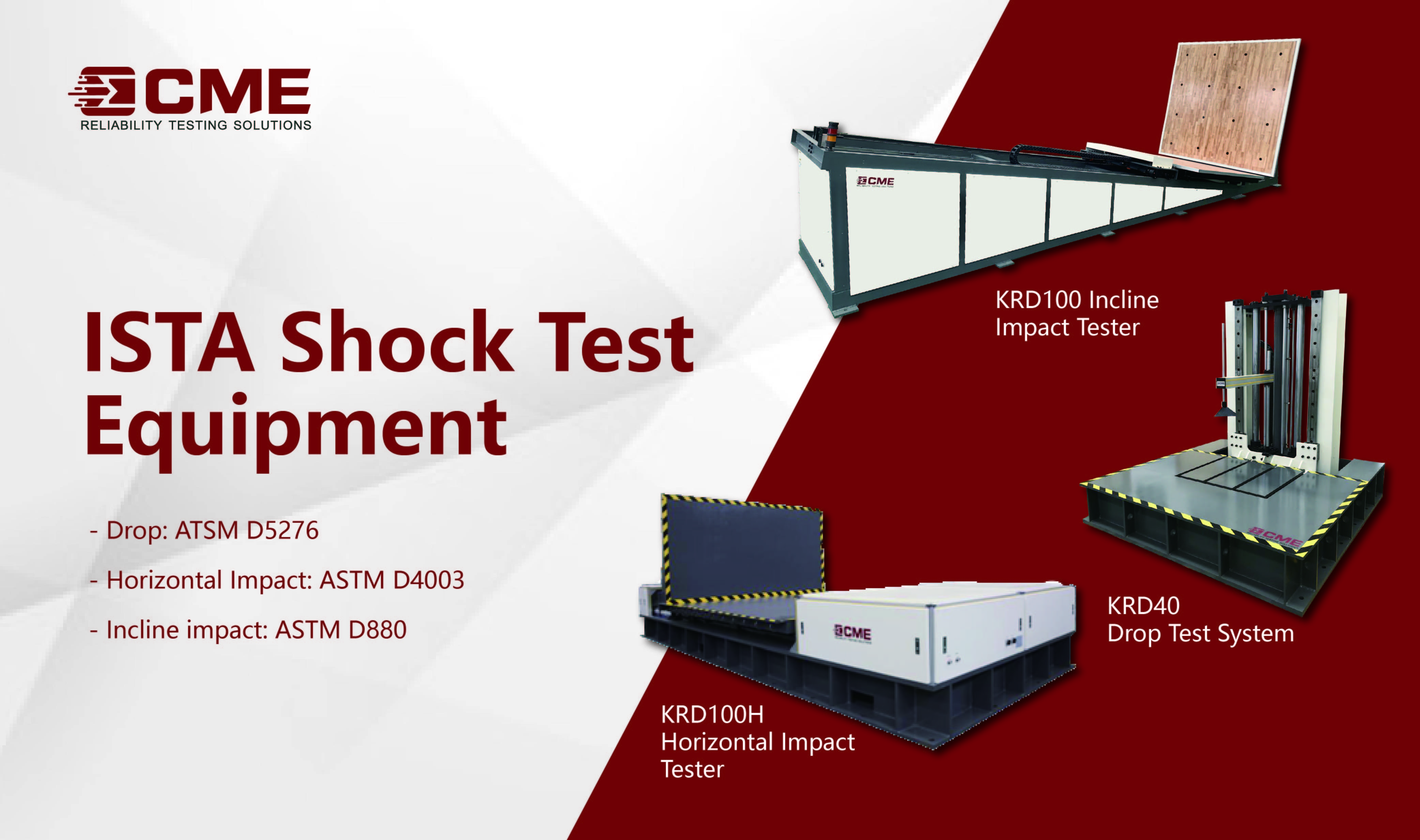
KRD40/KRD41/KRD42 Drop Test System
The drop test system is mainly used to test the drop resistance and impact performance of packaging products. They can realize the drop test of the test surface, edge and angle of the sample. The equipment is mainly used to evaluate the ability of product or packaging to withstand drops during transportation and loading and unloading, so as to improve product and packaging design.

- Model: KRD40 KRD41 KRD42
- Drop height (mm): 0~1500 300~1500 0~1200
- Maximum load (kg): 300 200 2000
- Test method: face, edge, angle
- Standard: ATSMD5276 ISTA1A, 1B, 1C, 1D, 1G, 2A, 2B, 2C, 3A, 3B, 3E, 3F, 3H, 3K, 6-AMAZON.COM-SIOC, 6-FEDEX
Performance characteristics
Driven by pneumatic and servo motors, stable lifting process with upper and lower displacement restrictions, safe and reliable;
Adopt single-track or dual-track lifting method, and the height can be adjusted arbitrarily;
It can clamp and drop the test specimen in different directions such as edges, faces and angles;
Fully automatic Omron PLC control; high-precision displacement sensor is equipped with high-precision collector;
No special foundation required, no other complicated operation or installation;
Optional handheld pad control + human-computer interaction system
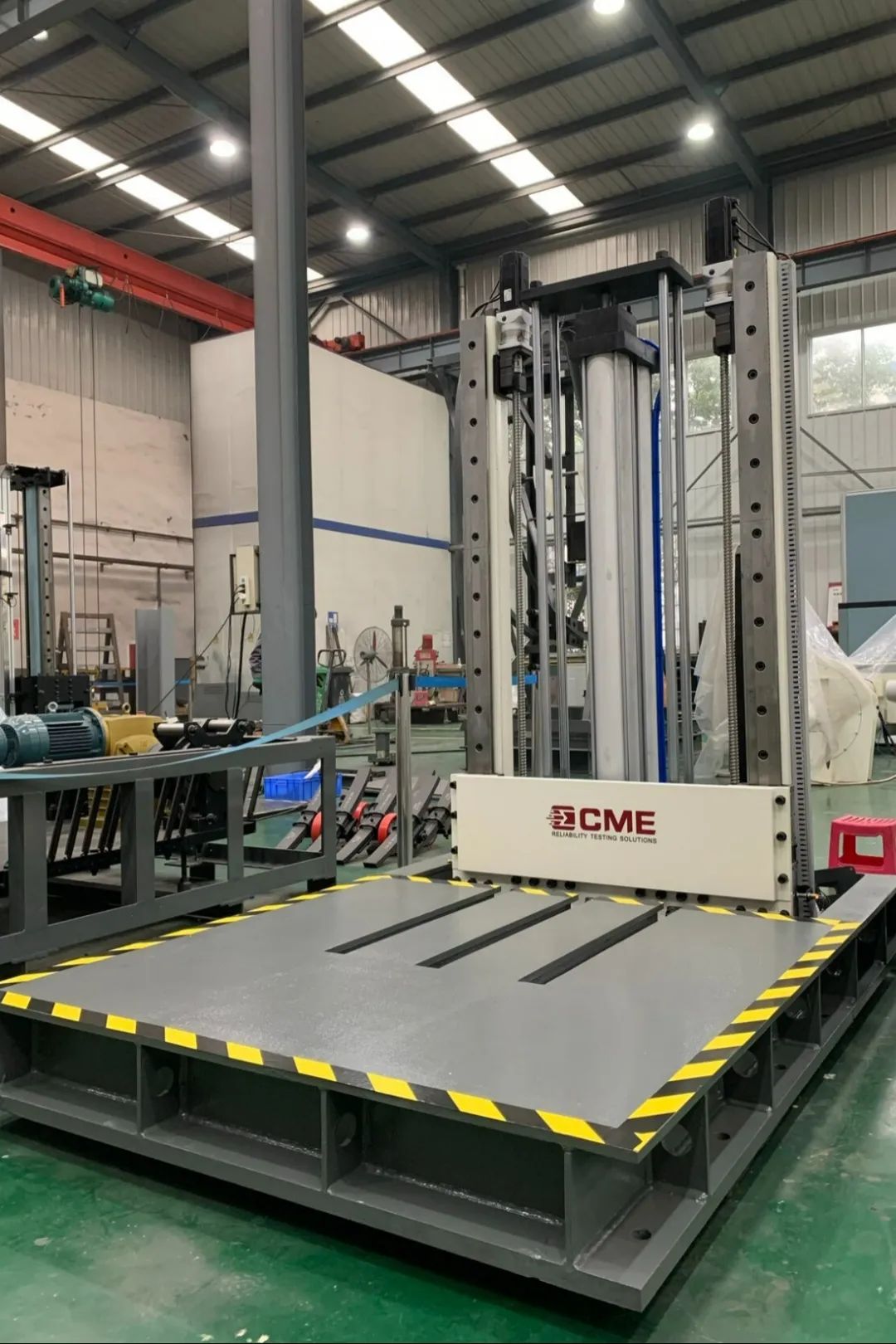

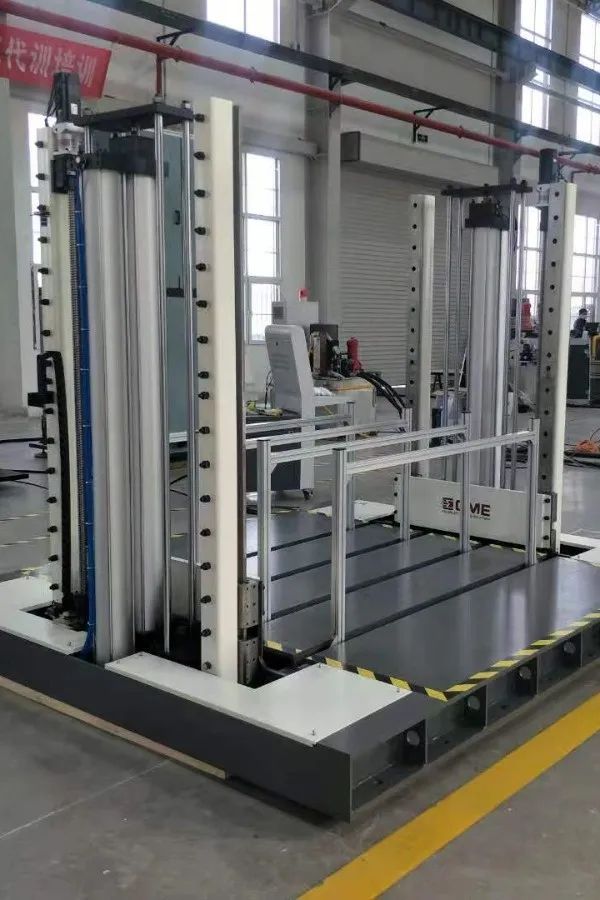
KRD100 Incline Impact Tester
KRD100 series incline impact testing machine simulates the ability of product packaging to resist impact damage in the actual environment, such as handling, stacking of shelves, motor sliding, loading and unloading of locomotives, product transportation, etc. This machine can also be used as common test equipment for scientific research institutions, colleges and universities, packaging technology test centers, packaging materials manufacturing plants, and foreign trade, transportation and other departments to conduct incline impact test.

- Model: KRD100
- Max. load (kg): 3000
- Shock velocity range (m/s): 1.2~3.87/ 0.59~2.35 (customizable)
- Standards: ISTA 1A, 1B, 1E, 2A, 2B, 3B, 3E, ATSM D 880, ASTM D 5277
- Sliding track and horizontal inclination angle: 10°±1°
Performance characteristics
Flexible low-damping tackle, high repetition accuracy, to achieve the required speed change value.
High-strength and low-friction profile guide rails are beneficial to the accurate free sliding of the block.
For heavy-duty test products, the horizontal rotation mechanism of the composite pulley table can be added to facilitate the user to install the test pieces.
Hard wooden or iron sliding table, effectively protect the surface of the test piece.
Complete control and measurement system, simple and convenient operation, integrated control and measurement.
Unique lifting and release methods, with obvious advancement and reliability.
During installation, the customer only needs to fix the machine on the ground, without other complicated operations or installation.

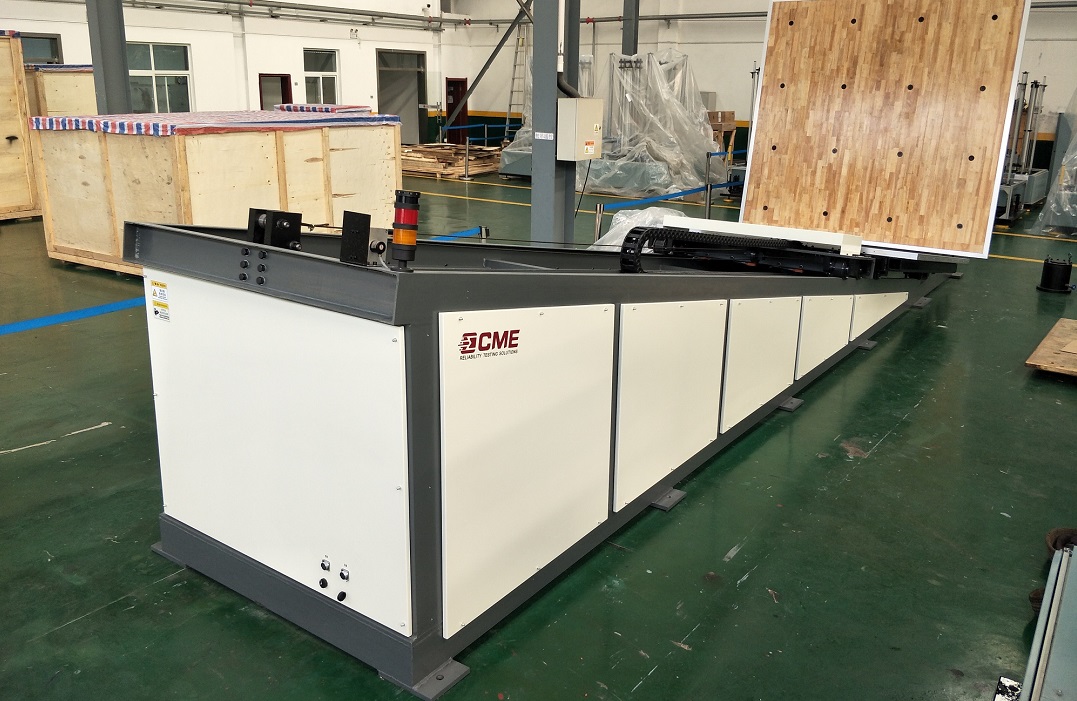
KRD100H Horizontal Impact Tester
The KRD100H horizontal impact tester is used to measure and determine the horizontal impact strength of a product or package and to assess the reliability and structural integrity of the test unit in a horizontal impact environment.
Horizontal impact tests according to ISO 2244 - Packaging - Complete filled transport packaging. This test can be used either as a single test to investigate the effects of horizontal shock, or as part of a series of tests to measure the resistance of packaging to systems containing horizontal shock hazards.
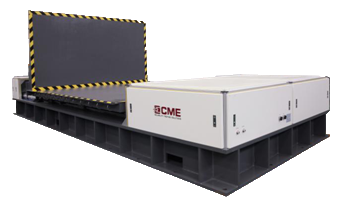
- Model: KRD100H
- Maximum load (kg): 2000
- Table size (mm): 2400*2400
- Shock velocity: 3.5m/s
- Standards: ISTA 1A, 1B, 1C, 1E, 1G, 1H, 2A, 2B, 2C, 3B, 3E, 3K; ATSM D 4003; ASTM D 880
